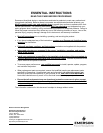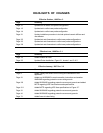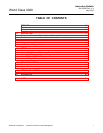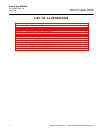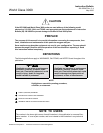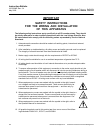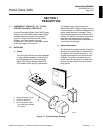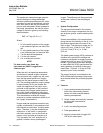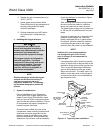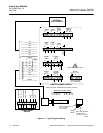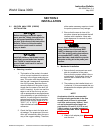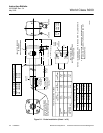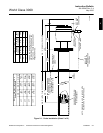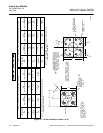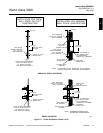
Instruction Bulletin
106-300NE Rev. 3.4
May 2000
1-2 Description Rosemount Analytical Inc. A Division of Emerson Process Management
World Class 3000
The equipment measures oxygen percent-
age by reading the voltage developed
across a heated electrochemical cell, which
consists of a small yttria-stabilized, zirconia
disc. Both sides of the disc are coated with
porous metal electrodes. When operated at
the proper temperature, the millivolt output
voltage of the cell is given by the following
Nernst equation:
EMF = KT log
10
(P
1
/P
2
) + C
Where:
1. P
2
is the partial pressure of the oxygen
in the measured gas on one side of the
cell,
2. P
1
is the partial pressure of the oxygen
in the reference gas on the other side,
3. T is the absolute temperature,
4. C is the cell constant,
5. K is an arithmetic constant.
NOTE
For best results, use clean, dry,
instrument air (20.95% oxygen) as a
reference gas.
When the cell is at operating temperature
and there are unequal oxygen concentra-
tions across the cell, oxygen ions will travel
from the high partial pressure of oxygen
side to the low partial pressure side of the
cell. The resulting logarithmic output voltage
is approximately 50 mV per decade. Be-
cause the magnitude of the output is pro-
portional to the logarithm of the inverse of
the sample of the oxygen partial pressure,
the output signal increases as the oxygen
concentration of the sample gas decreases.
This characteristic enables the oxygen
analyzer to provide exceptional sensitivity at
low oxygen concentrations.
Oxygen analyzer equipment measures net
oxygen concentration in the presence of all
the products of combustion, including water
vapor. Therefore, it may be considered an
analysis on a "wet" basis. In comparison
with older methods, such as the Orsat ap-
paratus, which provides an analysis on a
"dry" gas basis, the "wet" analysis will, in
general, indicate a lower percentage of
oxygen. The difference will be proportional
to the water content of the sampled gas
stream.
c. System Configuration
The equipment discussed in this manual
consists of two major components; the oxy-
gen analyzer (probe), and the heater power
supply.
Probes are available in five length options,
giving the user the flexibility to use an in situ
penetration appropriate to the size of the
stack or duct. The options on length are 18
inches (457 mm), 3 feet (0.91 m), 6 feet
(1.83 m), 9 feet (2.74 m), or 12 feet
(3.66 m).
The heater power supply (HPS) provides an
interface to the electronics package and
contains a transformer for supplying proper
voltage to the 44 Vac and 115 Vac probe
heaters. The enclosure has been designed
to meet NEMA 4X (IP56) specifications for
water tightness; an optional enclosure to
meet Class 1, Division 1, Group B (IP56)
explosion-proof is also available.
The oxygen analyzer is connected to the
HPS and electronics package using seven
wires housed within the connecting system
cable.
d. Features
1. Unique and patented cell protection
action that automatically protects
sensor cell when analyzer detects
reducing atmospheres.
2. Output voltage and sensitivity increase
as the oxygen concentration
decreases.
3. In situ, non-sampling analyzer.
4. Field replaceable cell.
5. Analyzer constructed of rugged 316
LSS for all wetted parts.



